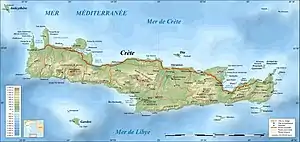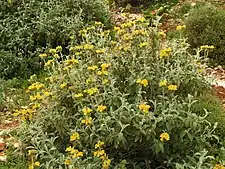Crete Mediterranean forests
The Crete Mediterranean forests is a terrestrial ecoregion that encompasses Greek the island of Crete.
| Crete Mediterranean forests | |
|---|---|
 Streamside forest in Zakros Gorge, Crete | |
 Topographic map of Crete | |
| Ecology | |
| Realm | Palearctic |
| Biome | Mediterranean forests, woodlands, and scrub |
| Geography | |
| Area | 8,450 km2 (3,260 sq mi) |
| Country | Greece |
| Elevation | sea level to 2,456 m |
| Conservation | |
| Conservation status | critical/endangered |
| Protected | 2662 km² (30%)[1] |
The island has a Mediterranean climate, and is in the Mediterranean forests, woodlands, and scrub biome found in the lands in and around the Mediterranean Sea. Crete's diverse habitats, from shrublands to forests, sustain 1600 species of plants, including dozens of endemic species.[2] The island was once characterized by forests, but centuries of human habitation have transformed the landscape, converting much of the original forest into shrublands, woodlands, fields, orchards, and pastures.
Geography
Crete lies in the eastern Mediterranean Sea. The Aegean Sea is to the north, and the Libyan Sea is to the south. It is about 160 km south of the Greek mainland. Crete is the largest island in Greece and the fifth-largest island in the Mediterranean, with an area of 8,336 km².
Crete extends 260 km from east to west, and its north–south width varies from 60 to 12 miles. A mountainous spine extends the length of the island, with three principal ranges: the White Mountains or Lefka Ori in the west (2,454 m), Psiloritis in the center (which includes Mt Ida, Crete's highest point at 2,456 m), and the Dikti Mountains in the east (2,148 m).
Geologically Crete is part of the Hellenic arc, created by the collision of the African and Eurasian tectonic plates starting 11 to 15 million years ago. Seas have divided Crete from the Greek and Anatolian mainlands for at least five million years. Crete's high mountains were uplifted 1.5 million years ago.[3]
Flora

The island's range of topography and soils support diverse plant communities. At lower elevations, low shrubland (phrygana) is common. Phrygana includes many aromatic plants, and typical species include Sarcopoterium spinosum, Thymus capitatus, Phlomis fruticosa, Phlomis cretica, Phlomis lanata, Cistus spp., Genista acanthoclada, Calicotome villosa, and spurge (Euphorbia spp.). There are also high shrublands (maquis) dominated by carob (Ceratonia siliqua), juniper (Juniperus phoenicea), and tree-spurge (Euphorbia dendroides), and woodlands and forests of evergreen and semi-evergreen oaks (Quercus coccifera and Quercus brachyphylla).[3][2] Groves of Cretan date palm (Phoenix theophrasti) are found in a few stream gorges around the island.
Woodlands of Calabrian pine (Pinus brutia) and Kermes oak (Quercus coccifera) are found at mid-elevations, along with maquis, and phrygana of Berberis cretica, Rhamnus saxatilis, Prunus prostrata, and Satureja spinosa.
Woodlands of Mediterranean cypress (Cupressus sempervirens) and Cretan maple (Acer sempervirens) are found at high elevations. Above the tree line (1600-1800 meters), thorny cushion scrublands grow on the highest peaks.[2][3]
There are 1,600 plant species on Crete, of which about 10% are endemic.[2]
Fauna
Crete is home to two endemic mammals, the Cretan shrew (Crocidura zimmermanni) and Crete spiny mouse (Acomys minous).[2]
The Kri-kri (Capra aegagrus cretica) is subspecies of feral goat found only in Crete's mountains and on nearby islands.
Extinct fauna
Crete's long isolation from the mainland made its fauna distinct. Dwarf elephants (Palaeoloxodon chaniensis and P. creutzburgi), the Cretan dwarf hippopotamus (Hippopotamus creutzburgi), Cretan dwarf mammoth (Mammuthus creticus), and Cretan dwarf megacerine (Candiacervus cretensis), a tiny deer, lived on Crete until the end of the Pleistocene epoch. These species are examples of insular dwarfism.
The Cretan owl (Athene cretensis), a giant flightless owl, and the Cretan otter (Lutrogale cretensis) also went extinct at the end of the Pleistocene.
Protected areas
There are several protected areas on Crete, including Samaria Gorge National Park.
External links
| Wikimedia Commons has media related to Crete Mediterranean forests. |
References
- Eric Dinerstein, David Olson, et al. (2017). An Ecoregion-Based Approach to Protecting Half the Terrestrial Realm, BioScience, Volume 67, Issue 6, June 2017, Pages 534–545; Supplemental material 2 table S1b.
- "Crete Mediterranean forests". World Wildlife Fund. Accessed 23 April 2020.
- Benda, Petr & Georgiakakis, Panagiotis & Dietz, Christian & Hanák, Vladimír & Galanaki, Kosmoula & Markantonatou, Vessa & Chudárková, Adéla & Hulva, Pavel & Horacek, Ivan. (2008). Bats(Mammalia: Chiroptera) of the Eastern Mediterranean and Middle East. Part 7. The bat fauna of Crete, Greece. Acta Soc. Zool. Bohem. ZoologyNatural History). 7287. 105-190.